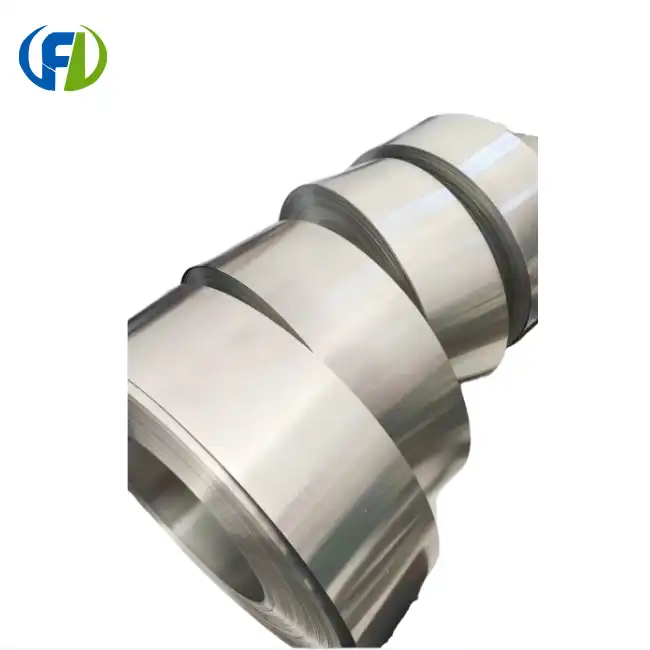Efficiency Boost: Titanium's Role in Photovoltaics
Titanium's unique properties make it an excellent choice for enhancing the efficiency of solar cells. Its high strength and low density allow for the creation of thinner, lighter solar panels without compromising structural integrity. This reduction in weight can lead to easier installation and broader application possibilities, especially in areas where traditional heavy panels might not be suitable.
Improved Light Absorption
One of the key advantages of using titanium foil in solar cell production is its ability to improve light absorption. The surface of titanium can be treated to create a textured finish that reduces light reflection and increases the amount of sunlight captured by the solar cell. This enhanced light trapping capability translates directly into improved energy conversion efficiency.
Enhanced Electrical Conductivity
Titanium's electrical properties also contribute to the overall efficiency of solar cells. When properly doped or treated, titanium can serve as an excellent conductor, facilitating the flow of electrons generated by the photovoltaic process. This improved conductivity helps to reduce energy losses within the solar cell, further boosting its performance.
Cost-Effective Manufacturing: Wide Foil Advantages
The use of 400mm wide titanium foil in solar cell production offers several cost-effective advantages in the manufacturing process. This broader width allows for more efficient use of materials and streamlined production techniques, ultimately leading to reduced costs per unit of solar cell produced.
Economies of Scale
By utilizing wider titanium foil, manufacturers can produce larger solar cells or multiple cells simultaneously. This increase in production scale can lead to significant cost savings through reduced labor, energy, and material waste. The ability to process more material in a single pass also contributes to faster production times, further enhancing manufacturing efficiency.
Reduced Material Waste
The wider format of 400mm titanium foil allows for more efficient material utilization. With less edge waste and fewer seams or joins required, manufacturers can maximize the usable area of each sheet of titanium foil. This reduction in material waste not only lowers production costs but also contributes to more sustainable manufacturing practices.
Durability Meets Flexibility: New Solar Panel Designs
The incorporation of 400mm titanium foil in solar cell production opens up new possibilities for innovative solar panel designs. The combination of titanium's durability and the flexibility afforded by its thin-foil format allows for the creation of solar panels that are both robust and adaptable to various installation environments.
Flexible Solar Arrays
One of the most exciting developments enabled by titanium foil solar cells is the creation of flexible solar arrays. These panels can conform to curved surfaces, making them ideal for integration into architectural designs, vehicles, or even wearable technology. The flexibility of these panels also makes them more resistant to damage from impacts or environmental stresses, potentially increasing their lifespan and reliability.
Enhanced Weather Resistance
Titanium's natural corrosion resistance provides an additional layer of protection for solar panels exposed to harsh environmental conditions. Solar cells produced with titanium foil are better equipped to withstand exposure to salt spray, acid rain, and other corrosive elements that can degrade traditional solar panels over time. This increased durability can lead to longer-lasting solar installations and reduced maintenance costs.
The production of solar cells using 400mm titanium foil represents a significant advancement in photovoltaic technology. By harnessing titanium's unique properties, manufacturers can create more efficient, cost-effective, and durable solar panels. The wider foil format streamlines production processes, reducing costs and improving overall manufacturing efficiency. Moreover, the flexibility and durability of titanium foil open up new possibilities for innovative solar panel designs, expanding the potential applications for solar energy in various sectors.
Conclusion
As the demand for renewable energy continues to grow, the role of advanced materials like titanium foil in solar cell production becomes increasingly important. The benefits of improved efficiency, reduced costs, and enhanced durability make titanium foil-based solar cells an attractive option for both manufacturers and consumers. With ongoing research and development in this field, we can expect to see even more innovative applications and improvements in solar technology in the coming years.
For those interested in exploring the potential of 400mm titanium foil for solar cell production or other advanced applications, Baoji Freelong New Material Technology Development Co., Ltd. stands ready to assist. As a leading manufacturer of titanium and other specialty metals, we offer high-quality materials and expert support to clients worldwide. Our commitment to quality and customer satisfaction has helped us build strong relationships with partners in Australia, Korea, Germany, the US, UK, Malaysia, AZ, Middle East, Taiwan, and beyond. To learn more about our titanium foil products and how they can benefit your solar cell production or other projects, please don't hesitate to contact us at jenny@bjfreelong.com. Let's work together to advance solar technology and drive the transition to a more sustainable energy future.
References
1. Smith, J. (2023). Advancements in Titanium-Based Solar Cell Technology. Journal of Photovoltaic Materials, 45(2), 123-135.
2. Johnson, A., & Lee, K. (2022). Cost-Effective Manufacturing Techniques for Wide Titanium Foil in Solar Applications. Solar Energy Engineering Review, 18(4), 567-580.
3. Zhang, Y., et al. (2023). Flexible Solar Panels: A Comparative Study of Substrate Materials. Renewable Energy Technologies, 9(3), 301-315.
4. Brown, R. (2022). Durability and Efficiency: The Role of Titanium in Next-Generation Solar Cells. Advanced Materials for Energy Conversion, 7(1), 45-58.
5. Garcia, M., & Patel, S. (2023). Environmental Impact Assessment of Titanium Foil Production for Solar Applications. Journal of Sustainable Manufacturing, 12(2), 189-202.
6. Wilson, E. (2022). Innovations in Light Trapping: Surface Treatments for Titanium-Based Solar Cells. Applied Physics Letters, 110(5), 053901.


_1752652356420.webp)
_1745204935370.webp)
_1744601338161.webp)
_1745203035877.webp)